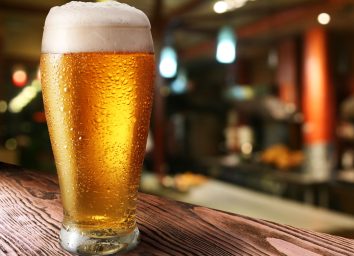12 Best Foods for Defined Abs
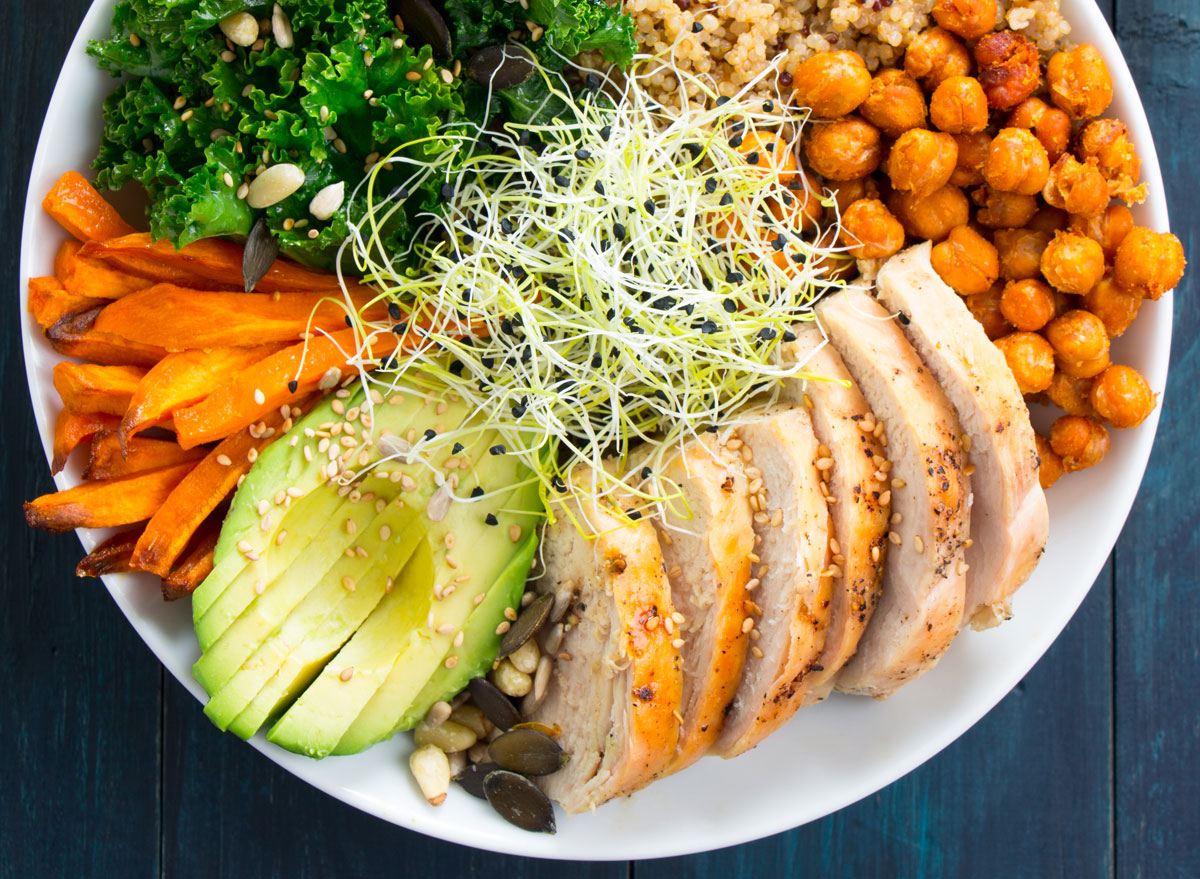
It’s no secret that regular exercise plays a crucial role in sculpting your midsection. However, the saying “abs are made in the kitchen” exists for a reason. Whether your goal is to reveal those hidden muscles or maintain your hard-earned six-pack, the foods you eat play a pivotal role in ab definition.
“Diet plays a crucial role in achieving more defined abs because it directly affects your body fat percentage and overall body composition,” says Trista Best, RD, a registered dietitian with Balance One Supplements. “To reveal well-defined abdominal muscles, you must reduce body fat while also building and maintaining muscle mass.”
The best foods to reveal your abs by burning body fat and supporting muscle growth range from lean proteins to fiber-rich fruits and healthy fats—and we’re here to share exactly what these foods are. While the following foods aren’t magic pills for six-pack abs, they are packed with nutrients that support muscle growth, fat loss, and overall health. When combined with a proper fitness routine, they can make a significant difference.
If you’re ready to discover the best foods to help you achieve those defined abs you’ve always wanted, keep reading. Then, don’t miss the 9 Best High-Protein Foods for Building Lean Muscle.
Chicken Breast
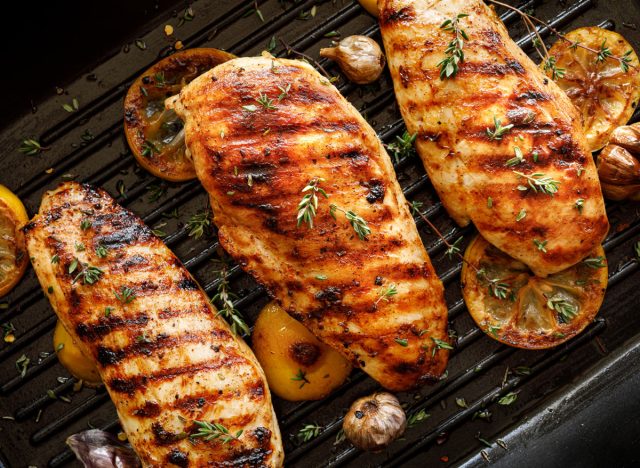
When building defined abs, lean protein is your best friend. And with 23 grams of protein per 100-gram serving, chicken breast is packed with this mighty macronutrient, which helps repair and build your muscles. Plus, it’s low in fat, making it an excellent choice for those looking to shed belly fat.
“Lean protein sources like skinless chicken breast are low in calories and high in protein, helping with muscle repair and growth,” says Best.
Salmon
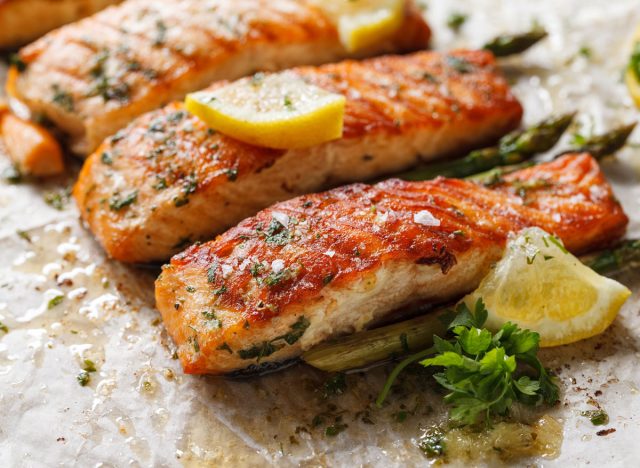
Salmon is a superstar for its omega-3 fatty acids and high-quality protein content. Research shows that the healthy fats found in fatty fish like salmon help reduce inflammation and promote a lean physique. Additionally, eating salmon regularly can boost your metabolism and keep you feeling full and satisfied.
Best says, “Fatty fish like salmon are rich in omega-3 fatty acids, which can reduce inflammation and support overall health while providing protein.”
Greek Yogurt
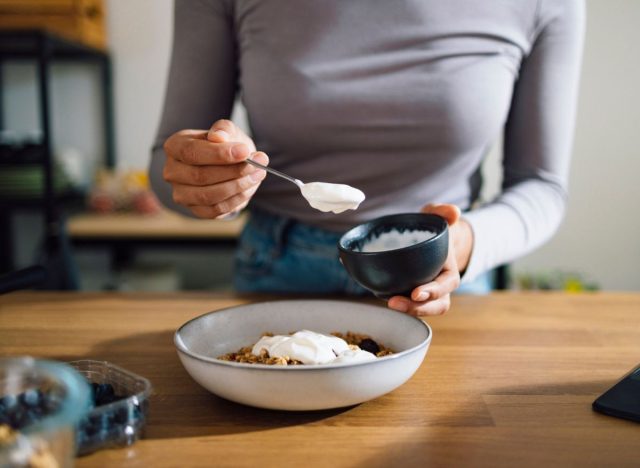
Greek yogurt is a protein powerhouse with 10 grams of protein per 100 grams. It’s also rich in probiotics that support digestion and help maintain a healthy gut. It’s a versatile food that can be enjoyed with fruits, nuts, or honey, making it a tasty addition to your ab-friendly diet.
“High in protein and probiotics, Greek yogurt can aid digestion and promote a feeling of fullness,” states Best.
Eggs
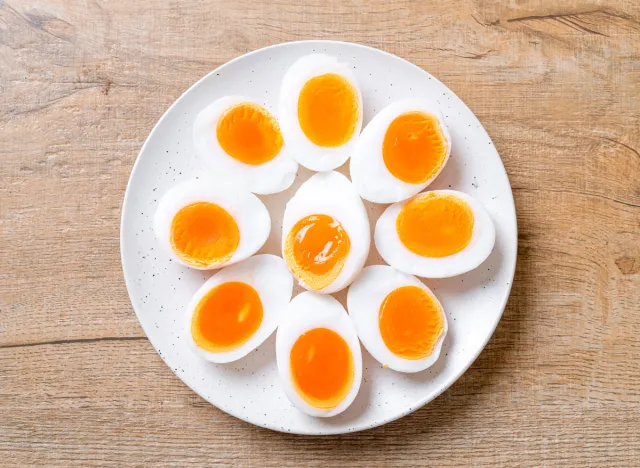
Eggs are a breakfast staple for a reason. They’re loaded with protein, vitamins, and minerals, which studies show can help you feel full throughout the day, reducing the temptation to snack on less healthy options. This increased satiety is crucial for maintaining a defined midsection.
“Eggs are a complete protein source and contain essential amino acids important for muscle development,” explains Best.
Leafy Greens
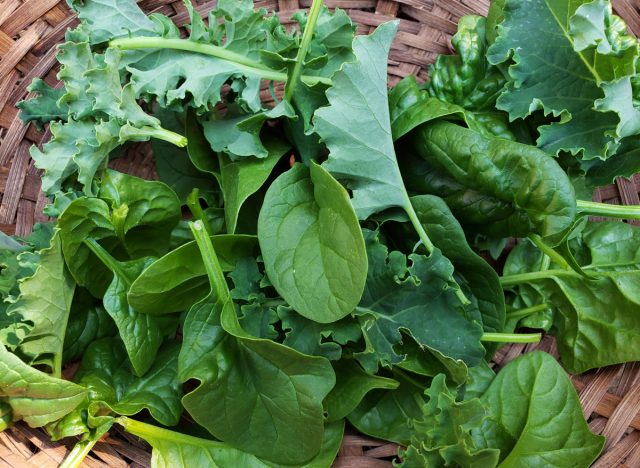
Leafy greens like spinach, kale, and Swiss chard are low in calories but high in nutrients, including fiber and vitamins. The phytochemicals in leafy greens have been shown to help control your appetite, support digestion, and provide essential nutrients for muscle recovery.
Best says, “Vegetables like spinach, kale, and Swiss chard are low in calories and packed with fiber, vitamins, and minerals that support overall health and digestion.”
Berries
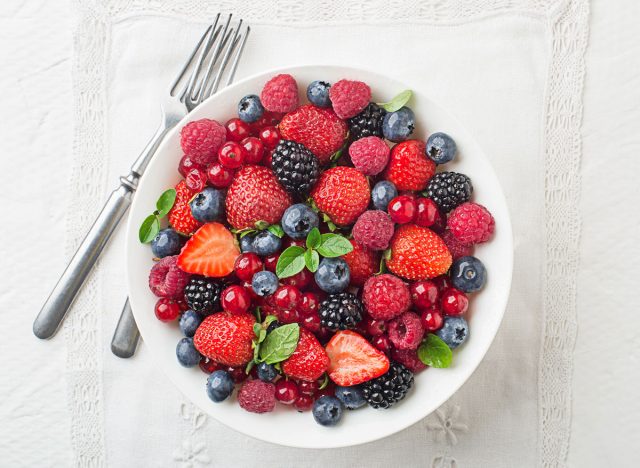
Blueberries, strawberries, and raspberries are more than nature’s candy — they’re also low in calories and high in antioxidants. This makes berries a superb choice for satisfying your sweet tooth while staying on track with your ab goals.
“Berries can help sculpt defined abs and aid in recovery from exercise due to their high antioxidant and low calorie content,” says Best.
Oats
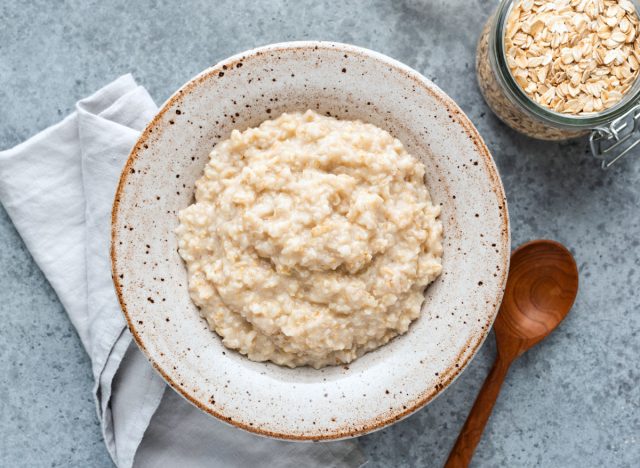
Oats are a fantastic source of complex carbohydrates and fiber, helping to stabilize blood sugar levels and keep you full. This whole grain is an ideal choice for a hearty breakfast that keeps you energized throughout the morning.
“Oats are a good source of complex carbohydrates and fiber, providing lasting energy and helping to regulate blood sugar levels,” explains Best.
Quinoa
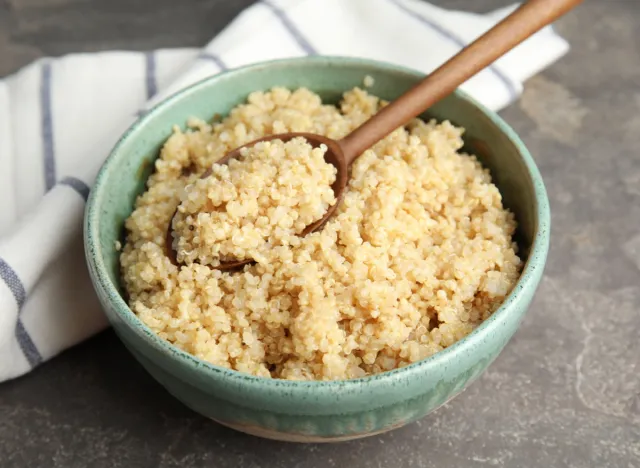
Quinoa is a complete protein, meaning it contains all nine essential amino acids. This whole grain is also packed with fiber, making it an excellent choice for building muscle and maintaining a healthy weight.
“Quinoa is a protein-rich grain that’s an excellent choice for muscle development and defined abs,” states Best.
Avocado
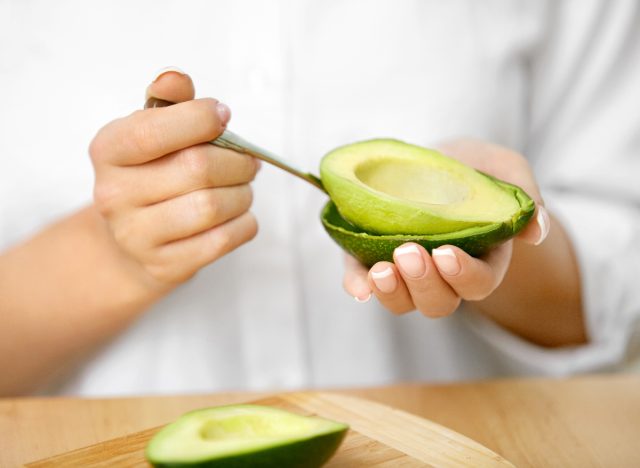
Avocados are creamy, delicious, and packed full of healthy monounsaturated fats. According to a 2019 study, these fats are essential for overall health and can help reduce visceral belly fat.
Best says, “Avocados are rich in healthy fats, particularly monounsaturated fats, which can help control appetite and support overall health.”
Nuts
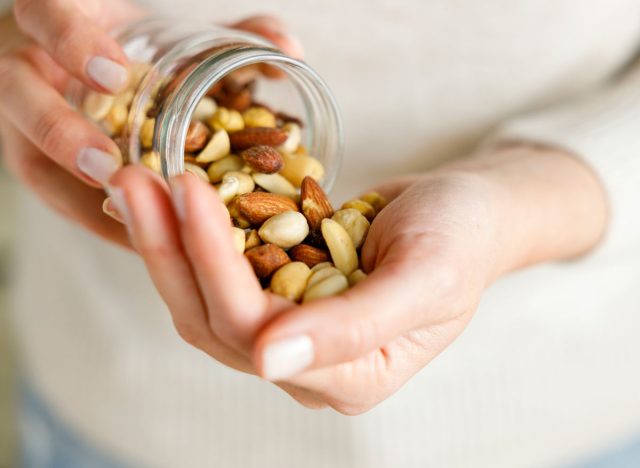
Nuts like almonds and walnuts are rich in healthy fats, protein, and fiber. For example, 100 grams of almonds provides 13 grams of fiber. Nuts are a satisfying snack whose nutritional profile supports muscle growth and helps you feel full between meals.
“Almonds, walnuts, and other nuts provide healthy fats, protein, and fiber, making them a satisfying snack option,” says Best.
Legumes
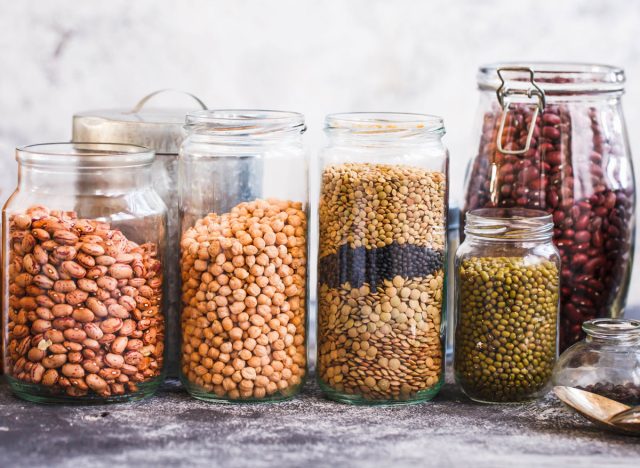
Legumes such as beans and lentils are loaded with protein and fiber, making them excellent choices for maintaining a lean physique. One hundred grams of lentils delivers 29 grams of healthy plant-based protein. Legumes are also highly versatile and can be used in various dishes.
“Beans, lentils, and chickpeas are rich in fiber and protein, helping you stay full and satisfied,” says Best.
Water
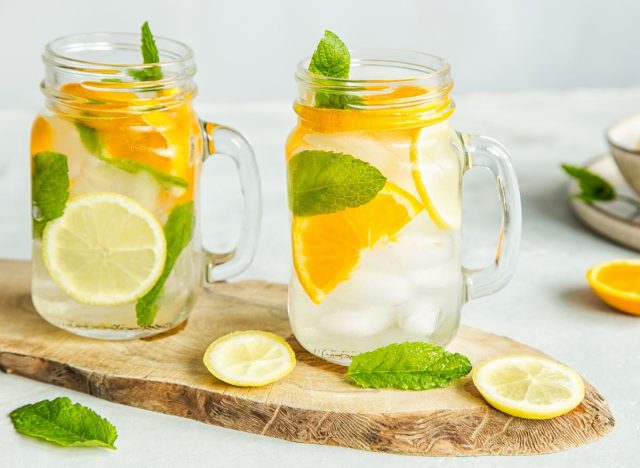
Staying hydrated is an often overlooked but crucial aspect of achieving defined abs. According to a 2019 study, water helps your body function optimally, aids digestion, and can prevent overeating by helping you feel full. It’s the simplest and most essential component of any abs-friendly diet.
Best says, “Staying hydrated with water is crucial for overall health, digestion, and metabolism. It can also help control appetite and prevent overeating.”
- Source: https://fdc.nal.usda.gov/fdc-app.html#/food-details/577591/nutrients
- Source: https://www.ncbi.nlm.nih.gov/pmc/articles/PMC7400877/
- Source: https://www.ncbi.nlm.nih.gov/pmc/articles/PMC8199776/
- Source: https://fdc.nal.usda.gov/fdc-app.html#/food-details/170903/nutrients
- Source: https://www.ncbi.nlm.nih.gov/pmc/articles/PMC5374383/
- Source: https://www.ncbi.nlm.nih.gov/pmc/articles/PMC7432073/
- Source: https://www.ncbi.nlm.nih.gov/pmc/articles/PMC9102588/
- Source: https://www.ncbi.nlm.nih.gov/pmc/articles/PMC8271923/
- Source: https://www.ncbi.nlm.nih.gov/pmc/articles/PMC4690088/
- Source: https://www.ncbi.nlm.nih.gov/pmc/articles/PMC7074363/
- Source: https://www.ncbi.nlm.nih.gov/pmc/articles/PMC6893766/
- Source: https://www.ncbi.nlm.nih.gov/pmc/articles/PMC5748761/
- Source: https://fdc.nal.usda.gov/fdc-app.html#/food-details/170567/nutrients
- Source: https://fdc.nal.usda.gov/fdc-app.html#/food-details/2025325/nutrients
- Source: https://www.ncbi.nlm.nih.gov/pmc/articles/PMC6426280/

